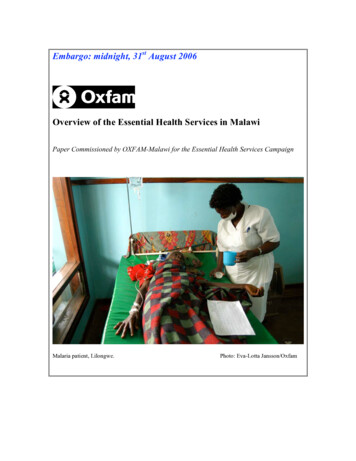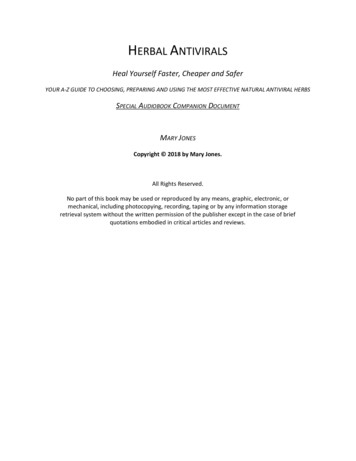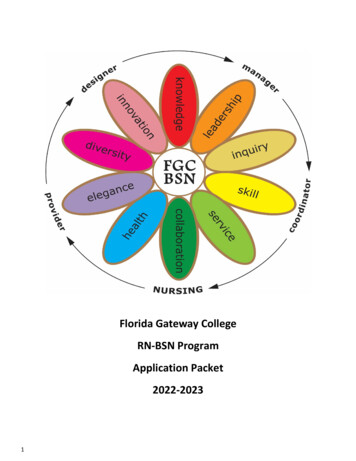
Transcription
Embargo: midnight, 31st August 2006Overview of the Essential Health Services in MalawiPaper Commissioned by OXFAM-Malawi for the Essential Health Services CampaignMalaria patient, Lilongwe.Photo: Eva-Lotta Jansson/Oxfam
Table of ContentsIntroductionHealth IndicatorsCauses of Poor HealthGovernment Policies on Health CareConceptual Understanding of the EHPBackground and Context of the EHP in MalawiConcept and Components of the EHPImplementation of the EHPThe Sector Wide ApproachStructures and Levels of Health Care in MalawiStatus of the Health Care in MalawiPrioritisation and Spending in the Health careChallenges and OpportunitiesOpportunitiesChallengesConclusion and tions for governmentRecommendations for donorsRecommendations for civil societyTable1: Allocations to the Ministry of HealthTable2 Gap Analysis of the Human Resource situation in MalawiTable3: Nurses and Midwives leaving MalawiTable4: Numbers of GoM and CHAM staff receiving top-upsTable5: MOH Payroll Deletions 2004-05Bibliography1
Executive summary“But the time I came here in 2000, about half the health centres were closed. The wholedistrict was supposed to have 104 nurses but when I came I found we only had 16 nurses.The district hospital was collapsing. It isn’t nice when you are supervising nothing. Itwas almost useless to go to health centres and find nobody.”Dowa District Hospital, MalawiMalawi is one of the poorest countries in the world. Life expectancy at birth wasestimated at 36.3 years in 2004, a sharp fall from the 1994 figure of 42 years. This islargely due to the HIV/AIDS epidemic. The problem of HIV and AIDS is compoundedby a very weak and under resourced healthcare system that is, in the words of one nurse:“weare really struggling. Beds are torn from overuse, equipment is breaking down.We’re always running short of gloves, and with AIDS is dangerous to work this way. Attimes we run short of panados, analgesics, antibiotics – very essential drugs. So we tellpatients to buy for themselves, and some can’t afford.”However despite these challenges the government is making progress. Under-fives andinfant mortality rates are steadily decreasing, and local communities have been givenmore say in the way healthcare resources are allocated. The capacity of the Ministry ofHealth to access and utilize HIPC (Heavily Indebted Poor Countries), MASAF and theHIV/AIDS Global funds to supplement government expenditures on health offers a greatopportunity to reduce the financing gap in the implementation of the Essential HealthPackage, the cornerstone the government’s healthcare policy.Despite commitments to healthcare and positive moves by the government such as thepolicy to decentralise healthcare management services, the government of Malawi is notspending enough on this vital sector. Under the Abuja Declaration on HIV/AIDS,Tuberculosis and other related diseases, adopted on 27 April 2001 by African heads ofstates and governments, the Malawi government agreed to spend at least 15% of itsnational budget on healthcare. In 2006 the government dedicated 8% of its nationalbudget to healthcare and is heavily reliant on donors to cover the much-needed additionalexpenditure for this sector. Consequently this has led to a dramatic shortfall in thenumber of healthcare workers needed to address the nation’s health requirements. Ahealth facility survey (JICA and MOH) conducted in 2003 showed that of the 26 districtsin Malawi, 15 (60%) had fewer than 1.5 nurses per health centre, while 5 (20%) had lessthan 1 nurse per health centre. It also showed that out of the 26 districts, 10 had no doctorin the government district hospitals and four had no doctor at all. The concentration ofhealthcare resources, including health workers, in larger urban centres is proving anobstacle to achieving the MDGs and is increasing the overall vulnerability of Malawiansto HIV and AIDS.Retention of healthcare personnel continues to be a real problem in Malawi. The Ministryof Health currently estimates that the vacancy rates for doctors, nurses and laboratorytechnicians in the public health sector range from 44% to 68%. The vacancy rates for2
specialist doctors (surgeons, obstetricians/gynecologists, physicians, pediatricians,pathologists, etc) in the public sector range from 71% to 100%( NAC M& E Report,December 2005). Between 2000 and 2001, 230 nurses left Malawi. Between July andNovember alone 17 junior doctors resigned, four of these moved to Christian HealthAssociation of Malawi, which offers a Euro 390 per month top-up through Cord-Aidfunding. It is not known where others went. The SWAP HR Technical Working Grouphas established a task team to explore this particular issue further and suggest anappropriate response. However it must be noted that in the context of figures for recentyears the 17 resignations are not unusual.The government has gone some way to address theses concerns. As part of theimplementation of its medium term Pay Policy, the government implemented a civilservice wide pay-rise in February 2006 (backdated to December 2005), which establishesa separate pay scale for health workers and led to a substantial wage increase.Since April 2005, the government, with the assistance from Department for InternationalDevelopment (DFID), introduced a retention package with the aim of preventing healthstaff from resigning. All cadres of professional health workers ranging from doctors todental therapists working in government institutions were targeted with a salary top-upallowance of 52% that has been included into basic gross pay.This package is a good motivator and should be backed by other major donors as a meansof ensuring that the healthcare sector is adequately staffed for the short and medium term.However the government needs to factor this issue into its long term financial planningfor the healthcare sector and steadily increase budget allocation to human resourcedevelopment. This would be in line with the six –year emergency training plan (2001-07)aimed at training an adequate number of health personnel to deliver the Essential HealthPackage (EHP).Recommendations to the government1. In order to ensure the effective decentralization of health care managementservices the government needs to develop the technical expertise of staff in thedistrict assemblies in the areas of planning, and budgeting and setting up moresystems of information management.2. The government needs to develop effective mechanisms to ensure that the districtassemblies manage the funding in a transparent manner so as to increase theiraccountability to local communities3. The government needs to move away from heavy reliance on unpredictable donorfunding and demonstrate its commitment to its own healthcare policies byallocating 15% of the national budget to healthcare, in line with its commitmentsunder the Abuja Declaration.4. The government needs to accelerate the Central Medical Stores reform in order tostrengthen drug logistics to ensure that the entire drug procurement anddistribution system offers reliability to local communities, increase accountabilityand transparency and reduce the potential for corruption in the health sector.3
5. Parliament and the executive arm of government, should sign bilateral agreementswith relevant countries to protect the Malawi government’s investment in trainedhealth and recipient countries consummately and formally compensate ensuringthat emigration of health and medical professionals.Recommendations to DonorsDonors should provide long term predictable funding to allow the Malawi healthservice to invest in staff training and development and in long-term infrastructuredevelopment.Donors such as USAID, GTZ, CIDA, among others, should provide funding to thegovernment to ensure that the government’s top up scheme for healthcare workers can beexpanded. 4
1.0 IntroductionMalawi is one of the poorest countries in the world, ranked 161 out of 174 (Humandevelopment Index, 2000) with a population of about 11 million people and per capitaincome of 180 (HIS, 1998). Over 65% of the population - approximately 6.5 millionpeople - live below the poverty line, the proportion being higher among rural residents(66.5%) than urban residents (54.9%). In addition to this poor economic index, income isunevenly distributed, with 80% of the wealth being in the hands of the richest 10% of thepopulation. This is according to the latest figures in the Malawi Poverty and VulnerabilityAssessment Report.1.1 Health IndicatorsLife expectancy at birth in Malawi has fallen sharply over the past decade; it wasestimated at 36.3 years in 2004 compared to around 42 in 1994. This decline has largelybeen attributed to the HIV/AIDS epidemic. Preliminary data from the MalawiDemographic Health Survey (MDHS, 2004), however, show that, in the period 2000-04,the under five mortality rate was 133 per 1000 live births while the infant mortality ratewas 76 per 1000 live births, figures which are substantially lower than those reported inthe preceding years. The under five mortality rates were 190 and 187 per 1000 live birthsin the periods 1990-1994 and 1995-1999 respectively. The corresponding figures forinfant mortality rates in these years were 104 and 112 respectively. Despite this recentimprovement, Malawi’s under-five and infant mortality rates remain among the poorestin sub-Saharan Africa and worldwide.The maternal mortality ratio (MMR) in Malawi rose sharply from 620 to 1120 per100,000 live births from 1992 to 2000. The preliminary report of the MDHS shows afigure of 984 maternal deaths per100, 000 live births. Even with this figure, again Malawiremains one of the countries with the highest MMR in the world.Malnutrition is a serious problem among children in Malawi. The rates of malnutrition orstunting (restriction of growth due to chronic under-nutrition) among under five childrenhave remained constant since 2001. The MDHS 2004 indicate that 48% of under-fivechildren were malnourished or stunted as compared to 49% in 2001. Recurrent foodshortages due to poor rains and the low education status of rural communities are amongthe major reasons for the persistent malnutrition problem. Malnutrition increases childrensusceptibility to a host of infectious diseases, as well as stunting intellectual growth.1.1.1 Cause of the poor health indicators“In most cases we don’t have enough equipment, infrastructure or instruments. We’resupposed to have a scanning machine but we don’t have it. Transport is a problem. Weonly have two ambulances for the district and our vehicles are very old. The equipment intheatre isn’t enough. We have one sterilising machine but when we wanted to do a C-5
section for a patient it broke down. We had to take the patient to Lilongwe. Yes, lives arelost.”Health Officer, Dowa District Hospital“If you can’t even find a thermometer how can you give patients quality care?”Nurse, Kamuzu Central Hospital, Lilongwe.The majority of the causes of morbidity and mortality in Malawi are preventable. Inchildren, infectious diseases such as malaria, pneumonia, and diarrhoea are the majorcontributors. In pregnant women, the major causes of death are bleeding before or soonafter delivery (pre- and postpartum haemorrhage) and reproductive system infections,which develop after delivery. These deaths are easily prevented with the provision of theright health care.HIV and AIDS is currently the leading cause of morbidity and mortality in the mostproductive age group (20-49years). As a result of the HIV epidemic, Tuberculosis (TB)has become an important direct cause of morbidity and mortality in this age group. Thenumber of reported TB cases has increased at least five fold in the last 20 years, from4,863 in 1984 to 26,375 in 2004 (Malawi National TB Control Program, 2004). Themajor underlying poor health indicators include widespread poverty, chronicmalnutrition, low education status (particularly among women), poor sanitation, pooraccess to safe water, and inadequate capacity of the health care system to deliver qualityand accessible health services. According to MOHP, 2003 report, it is estimated that only61% of the population has access to safe drinking water (94% of urban and 56% of ruralpopulation), and 78% have good sanitation facilities (97% urban and 75% rural).6
Above: Babies with suspected malaria, Kamuzu Central Hospital, Lilongwe.Photo: Caroline Hooper-Box/OxfamThe majority of the causes of morbidity and mortality in Malawi are preventable. Inchildren, infectious diseases such as malaria, pneumonia, and diarrhoea are the majorcontributors.1.2 Government Policies on Health CareThe Ministry of health and Population (MOHP) is mandated to set policies for the healthsector. Currently, the overall policy goals of the health sector set by the Ministry is toraise the level of health status of all Malawians though a delivery system capable ofpromoting health prevention, reducing and curing diseases, protecting life and fosteringthe general well-being and increased productivity, and reducing the occurrence ofpremature death.In support of the overall health sector, five supporting health sector policies (strategies)were adopted to guide the operations of the health sector (MOHP, April 2003). These are:1. Introduction of the Essential Health Care Package (EHP)2. Implementation of the Bakili Muluzi Health Initiative (BMHI)3. Introduction of the Sector Wide Approach (SWAP)7
4. Decentralization of the Health Care Management Services5. Introduction/Strengthening of Cost Recovery/User FeesThis report will focus on EHP, SWAP and the decentralization of the Health CareManagement Services2.0 Conceptual Understanding of the Essential Health Package (EHP)2.1 Background and context of the EHP in MalawiThe EHP in Malawi is based on the country’s implementation of the Primary Health Carestrategy whose fundamental principle is to improve the health status of the population byfocussing on a cost effective package of essential health services through the involvementof the beneficiaries themselves in service delivery.The Ministry of Health (MOH) indicated its intention to adopt the EHP in its 4th NationalHealth Plan (NHP) covering the period 1999-2004. The policy objective was to focus onpromoting the provision of a basic, cost effective package of preventive and curativehealth services determined on the basis of scientific and practical experience in servicedelivery and its ability to have a significant impact on the health status of the majority ofthe population.The EHP addresses the major causes of morbidity and mortality that mainly affect thepoor and most vulnerable groups in society. Because it targets the poor, it constitutes amajor part of the MOH’s contribution to the implementation of the country’s PovertyReduction Strategy (PRS). Thus, the EHP is expected to contribute to the country’seconomic development by improving the health status of the poor and thus renderingthem potentially capable of uplifting themselves from poverty. To ensure maximumbenefit by the poor, it is government policy that the EHP be provided “free” of charge atthe point of delivery at all public health facilities. This implies that every Malawian isentitled to EHP services at any government facility free of charge irrespective of theirsocio-economic status. Where government facilities have introduced “private wards” anduser fees are enforced, only those patients choosing to access such privileged serviceswill pay the requires fees.2.2 Concept and Components of the EHPThe Essential Health Package (EHP) was developed as a means to limit the scope ofhealth services to a narrow range of effective interventions, which will match availableresources, and as a way of priority setting. There is realization that providing a wholerange of service is not always possible in a resource constrained environment if qualityand effectiveness are to be maintained. The idea behind EHP is to select only those costeffective interventions which when delivered will complement each other, reduce thetotal cost to both the provider and client and will address the major causes of death anddisease in the population. The rationale behind the EHP as a pro-poor strategy is its focuson the major causes of morbidity and mortality, both amongst the general population and8
particularly on medical conditions and service gaps that disproportionately affects therural poor. The EHP is expected to be cheaper to deliver because the interventions sharethe same technology, are delivered by multi-skilled health workers and share the samefacilities i.e. at one visit, it is possible to access more than one service e.g. postnatal carefor the mother, immunization for the baby and the management of other child hoodinterventions of children under the age of five years.Above: A cheerful sight for children at Kamuzu Central Hospital, Lilongwe.Photo: Eva-Lotta Jansson/OxfamThe EHP is thus the basis for health service planning and budgeting in Malawi. Themedium term health strategy for the sector, the Sector Wide Joint Program of Work(POW) 2004-2010, is based on the need to improve access to quality EHP services.The following disease conditions comprise EHP in Malawi: Vaccine PreventableDiseases (EPI), Malaria, Adverse maternal and neonatal outcomes (including familyplanning/reproductive health/safe motherhood initiatives), Tuberculosis, AcuteRespiratory Infections (ARI), Acute Diarrheal diseases, Sexually Transmitted Infections(STIs), Schistosomiasis, nutritional deficiencies, common injuries, eye, ear and skininfections.9
2.2.1 Implementation of the EHP2.2.2 The Sector Wide Approach (SWAP)The Malawi Government (GoM), adopted SWAP as the over arching strategy for overallhealth development in Malawi. In Malawi, as in a number of sub-Saharan Africancountries, the concept of SWAP has gained support as a means of getting partnersgovernment, donors and other non-governmental stakeholders - to work together in orderto develop and operate the systems and structures for effective and equitable healthservice delivery. This move came as a result of re-thinking the modalities of externalsupport and how to ensure that it is used in the most effective manner.Under this approach, the Malawi EHP is intended to provide the basis for a shared visionof the health sector in terms of what should be supported with public funds, includingexternal support. This process in Malawi, begun with the joint development of theNational Health Plan. The SWAP therefore, can be seen as a mechanism for sectoralplanning around the MOHP core business of the EHP service delivery; and, as a means ofenhancing donor coordination and joint working.The core aim of SWAP is to provide quality EHP services free of charge at the point ofdelivery at all levels of the health system- primary, secondary and tertiary2.2.3 Structures and Levels of Health Care in MalawiHealth Services in Malawi are provided at three levels; primary, secondary and tertiary.At primary level, services are delivered through rural hospitals, health centers, healthposts, outreach clinics and community health initiatives such as Drug Revolving Funds.District and Christian Health Association of Malawi (CHAM) hospitals providesecondary level health care services. The secondary level provide surgical back upservices, mostly for obstetric emergencies and general medical and pediatric in patientcare for common acute conditions. The tertiary or central hospitals act as referralhospitals, to which district hospitals send their difficult cases.10
11
12
Above: A nurse cleans bedding at the Kamuzu Central Hospital, Lilongwe.Photo: Caroline Hooper-Box/OxfamIn short, the health system in Malawi works through a referral network. Patients are firstexpected to contact one of the points at the lower level of the system – usually the healthcentre. If the patient needs more complicated treatment than the health centre can offer,the patient is referred to the district hospital. In-turn, if the district hospital cannot cope,the patient is referred to the central hospital. The main objective of a referral system is toensure that the health sector guarantees continuity of care for the EHP. Findings from thebudget tracking exercise conducted by MHEN (2006 draft) reveal that, in some casesstaff are forced to refer patients they would otherwise have treated either because theyhave run out of drugs or equipment is not available. In some cases staff will not be able torefer patients on time because the communication system is not working or ambulancesare not available. Most of the funding goes to the Central Hospitals on the premises thatthis is where most complicated illnesses are referred, hence the need for more resources.However, most of the rural poor people may not access these services due to delays inreferral and transport problems.3.0 Status of Health Care in Malawi3.1 Prioritisation and Spending in the Health CareThe Abuja Declaration on HIV/AIDS, Tuberculosis and other related diseases adopted on27 April 2001 by African heads of states and governments requires African governmentsto spend at least 15% of their national budget on health.The annual allocation to the health sector in Malawi since Abuja has ranged from 7% to10% of the national Budget. In this fiscal year 2006/07, the Health Sector has beenallocated a total budget of K10, 937,476,022. This represents 8% of the total governmentbudget, which is far below the Abuja Declaration’s minimum of 15%. K7, 838,702.022 isfor recurrent expenditure that comprises administration and support services, curativehealth services, among others.Table1: Total Allocations to Ministry of HealthItemApprovedRevisedfor Estimate forDescription Estimate for 2005/062006/072005/06Total Budget 8,703,752.857 12,359,707,317 10,592,466,752for HealthRecurrent6,982,85710,683,207,316 7,488,692,752Development 1,720,800,000 1,676,500,001 3,103,774,000(Capital)Part 11,475,800,00 1,475,800,000 2,956,774,000Part ge(1,767,240,565) (14)(1,215,060,105) .35(29.25)
585,99655.94Source: Ministry of Finance (2006): Budget Document number 3Despite the substantial increase in the commitment and availability of financial resourcesfrom donors and government since the mid-1990s, (e.g. Malawi Social Action Funds,HIPC, Global HIV/AIDS Funds) delivery of health services is currently hampered by thelack of skilled health workers, particularly in peripheral health facilities which providebasic health services to rural population. A health facility survey (JICA and MOH)conducted in 2003 showed that of the 26 districts in Malawi, 15 (60%) had less than 1.5nurses per health center, while 5 (20%) had less than I nurse per health center. It alsoshowed that out of the 26 districts, 10 had no doctor in the government district hospitalsand four had no doctor at all. These statistics were far worse than those from Malawi/sneighboring countries. The Ministry of Health currently estimates that the vacancy ratesfor doctors, nurses and laboratory technicians in the public health sector range from 44%to 68%. In addition to the above mentioned shortages, the vacancy rates for specialistdoctors (surgeons, obstetricians/gynecologists, physicians, pediatricians, pathologists,etc) in the public sector range from 71% to 100% ( NAC M& E Report, December 2005)About one million people are living with HIV and AIDS in Malawi. The number ofpeople in need of access to treatment, care and support is on the increase.3.2 HIV/AIDS and the Home Based Care Model“HIVAIDS has brought a lot of patients. We’re now dealing with double, three times thenumber of patients the hospital was designed to cater for. It’s frustrating.”Nurse, Kamuzu Central Hospital, Lilongwe:The National HIV/AIDS Policy (October 2003) stipulates that comprehensive treatment,care and support include the provision of ART and other medicines; diagnostics andrelated technologies for the care of HIV/AIDS, related opportunistic infections (OI) andother conditions, good nutrition, social spiritual and psychological support; and family orcommunity home-based care.HIV infection results in serious medical, emotional, psychological, social and economicconsequences for the affected individual and family. In addition, most opportunisticinfections associated with HIV infection can be treated with affordable drugs. Propernutrition and psychosocial support, including support counseling, as well as communityhome-based care (CHBC), can help to improve the quality of life. This argument coupledwith the failure of the health delivery system to care for every patient has led to themushrooming of Home Based Care groups (HBCs). The government policy is to promotethe delivery of quality CHBC as an essential component on the continuum of care forPLWHAs and to ensure that treatment of HIV/AIDS related infections is providedaccording to the EHP. However, lack or inadequate drugs for opportunistic infections14
compromise the HBC model. Poor patients have to walk long distances to the nearesthealth center to get drugs that are often unavailable.In addition, most of those involved in taking care of the sick in the HBC groups, are poor,marginalized and untrained women living in rural areas. The government must providesupport to the caregivers in form of training, drugs, gloves and other necessities to lightenthe burden and to enable them have quality essential health care services in Malawi.The daily reality of people living with HIV and AIDS is that they are confronted with ahealth system that is utterly overwhelmed: the numbers of health care providers aregrossly inadequate and inequitably distributed. The main constraints to scaling up theARV program are: Capacity of the health sector to deliver ARV drugs to people in needCapacity of UNICEF and Central Medical Stores to procure and distribute ARVdrugs to patients demanding for HIV testing and ARV therapyBy 2002, on average, Malawi had a population-to-nurse ratio of 3500:1 and populationto-doctor ratio of 64,000:1(JICA and MOH, Health Facility Survey, 2002). The Malawigovernment has been losing health workers, especially nurses and doctors, to the privatesector, foreign greener pastures like the United Kingdom. This has compounded theshortage of health workers.Table 2: Gap Analysis of the Human Resource Situation in d posts in the 16,39721,3374,940health sectorEstablishment of nurses in 2,1786,0843,906the public sectorEstablishment for Clinical 3,8522,8251,027OfficersMedical Assistants692327365Population to nurse ratio for hould be filledFill vacant postsFill vacant postsFill vacant m47.1 for SouthAfrica; 128.7 forZimbabwe; and85.2forTanzania (somedistrictsinMalawi have 1nurse per 7,800persons. Based
Nurses in health centres1.9 nurses2 enrolled 1nurse/midwivesNurses in district hospitals 1.5per facility21SurgeonsPathologists115221709822Medical s/gynecologists 12611115Pediatricians553 60on the Norm forAfrica, Malawineeds12,000nurses.Currently, it hasslightlyover4,000Thisisanindication thatmany are bynone at all.Somehealthcenters are nowmannedashealth posts byHealthSurveillanceAssistants with10 weeks oftraining.15of26districts haveless than 1.5nursesperfacility, and 5districts haveless than 1There100%vacanciesare71% vacanciesthat need to befilled91% vacanciesto be filled92% vacantThe number of facilities ready to implement the Essential Health Package basedon the Ministry’s expressed staffing pattern is 9.2%.There are 156 physicians working in MoHP and CHAM. The MoH has 103physicians working in all health facilities. Of these, 81 are working in CentralHospitals, with 22 available outside of these. On third of the 156 are withCHAM.16
WHO lower case of 30 years ago, call for 1 doctor per every 12,000 people. Atthis rate, Malawi needs another 850 medical doctors.There are 10 districts without a Ministry of health doctor and four districtswithout any doctor at all.The national ratio of doctors to population is 1.6 to 100,000. South Africa has56.3 per 100,000; Zimbabwe 13.9 and Tanzania has 4.1.Source: Ministry of Health, April 2004: Human Resources in the Health Sector:Toward a Solution“We have very good qualified people here. You are trying your best but you can be alonewith 90 patients. On the paediatrics ward you can find two nurses on night duty, lookingafter them all, critically ill children. They might need blood, emergency treatment,everybody comes to you wanting something. The nurse-patient ratio is very important.”Nurse, Kamuzu Central Hospital, Lilongwe.“The focus has been so much on those who are leaving. Maybe we should be focusing onthe people we have here. We need to seriously look at what we can afford to help them dowhat they have committed to doing as health workers.”Dr Douglas Lungu, Deputy Director (Clinical) in the Ministry of Health“The impact of the salary top up? It’s too early to say the impact so far but earlyindications are that might work. The top-up offers people hope. It can help us to retainpeople in the system. My worry is what happens after six years? This programme has tocontinue; we have to sustain it.”Health official, Lilongwe.Apart from deaths and retirements, brain drain has contributed a lot to the shortage ofhuman resource in the health sector. Table three below is a summary of the brain drain inthe health sector from 2000 to 2003. Between 2000 and 2001, 230 nurses left Malawi.Table 3: Nurses and Midwives that left Malawi after seeking validation certificatesfrom Nurses and Mid- Wives Council of MalawiYearUSBotswanaNewZealand2002315
aimed at training an adequate number of health personnel to deliver the Essential Health Package (EHP). Recommendations to the government 1. In order to ensure the effective decentralization of health care management services the government needs to develop the technical expertise of staff in the











